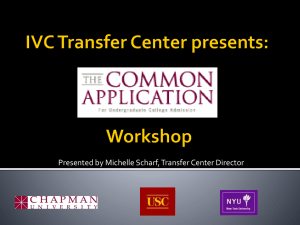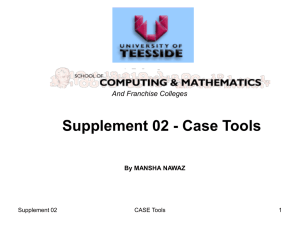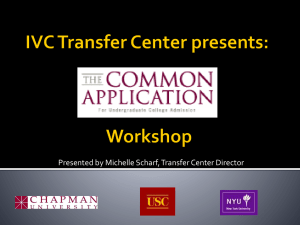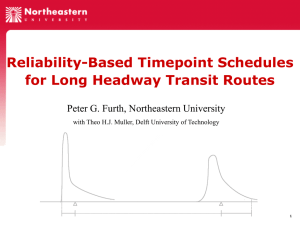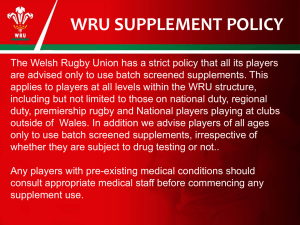Texas Higher Education *Formula Funding 101*
advertisement
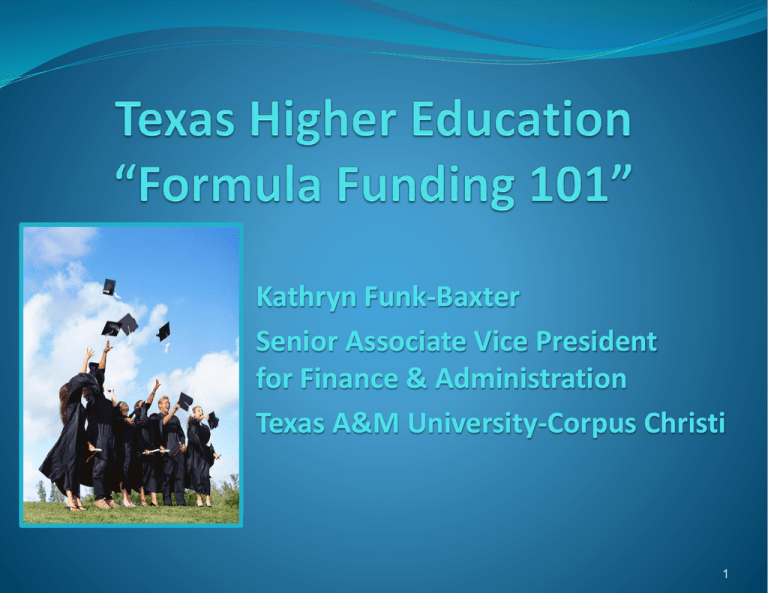
Kathryn Funk-Baxter Senior Associate Vice President for Finance & Administration Texas A&M University-Corpus Christi 1 Flow of funds to universities Funds flow to institutions of higher education in a number of ways: • Direct Appropriations-Formula funds and other direct appropriations based on identified needs • Special Items • Indirect Appropriations-not made directly to institution in its portion of bill but used to cover costs related to health insurance, retirement, and social security • Other Indirect Appropriations • Higher Education Fund • Higher Education Performance Incentive Funds • Dramatic Nursing Shortage Significance of Funding Formulas Formula Funded 18% Students Tuition & Fees 30% State Funded Debt Service & Capital 11% State Benefits 5% Restricted Income 21% External Funds Other Operating Income 4% State Funded Non-Formula 11% 18% of TAMUCC budget is formula funding 3 Formula Funding Two funding formulas and two supplements: • Instruction and Operations Formula • Teaching Experience Supplement • Infrastructure Formula • Small Institution Supplement How does the formula generate Instruction/Operations funds? Two basic concepts: • Weighted Semester Credit Hours • Base Period 5 Distribution of I/O Formula Funds to Texas Institutions of Higher Education UT 14% Other Academics 53% A&M 13% UH 7% TX Tech 7% UNT 6% Source: LBB 2008-2009 Biennium The Instruction and Operations Formula E&G Space Support 5,418,403 Small Institution Supplement 128,100 Teaching Experience Supplement 1,262,558 All amounts include General Revenue and Dedicated Appropriated Funds Instruction & Operations 28,108,802 7 What functions is it designed to fund? Faculty salaries Departmental operating expense Library Instructional support Research enhancement Student services Institutional support 8 The Importance of Credit Hours The two formulas are driven solely or partly by semester credit hours taught. The Instruction and Operations formula is driven totally by credit hours. The Infrastructure Support formula, in addition to credit hours taught, includes academic program mix, staff size, research expenditures, and Library collection size. The supplements are driven by sch and headcount. The Teaching Experience supplement is driven by the number of undergraduate credit hours taught by tenured or tenuretrack faculty. The Small Institution supplement is given to schools with less than 10,000 students. 9 The Financial Importance of Instruction The important research and service missions of the university bring with them virtually no direct formula funding. Special Items and Research Development Fund appropriations can provide funding for these activities. From the formula’s perspective, teaching generates semester credit hours and that counts in generating most of our state formula funding. 10 The “Base Period” The base period is the 12 month period used to measure the SCH to be included in the appropriations formulas. It is the summer and fall of even numbered years and the spring of odd numbered years. This “base period” provides the most recent year of semester credit hour data available when the legislature meets in the spring of odd numbered years. Base period SCH determines formula appropriations for the next two years. 11 What are weighted credit hours? We are funded by the number of credit hours we teach in the base period, but not all credit hours are funded at the same dollar value. Semester Credit Hours X Program/Level Weight X Rate ($62.19) Conceptually, the formula weighting is supposed to reflect the differences in cost related to teaching courses at different levels and in different academic fields. Graduate courses, for example, are expected to be taught in smaller class sections than undergraduate classes so graduate credit hours are weighted heavier than undergraduate credit hours. 12 What are weighted credit hours? Courses in different fields are also weighted relative to each other. For example, a credit hour in a lower division History course earns less formula funding than that of a lower division course in Art or Engineering. All these weightings are displayed in a chart called the “Formula Matrix”. 13 THECB Weighting Matrix Weighting Lower Div. Upper Div. Masters Doctoral Liberal Arts 1.00 1.72 4.18 9.29 Science 1.71 2.97 8.09 20.52 Fine Arts 1.39 2.32 5.43 7.19 Teacher Education 1.42 1.74 2.48 7.64 Agriculture 1.87 2.52 7.07 9.91 Engineering 2.41 3.87 7.63 15.96 Home Economics 1.06 1.70 2.86 6.62 Law Special Prof. 3.86 Social Services 1.94 2.05 2.97 13.84 Library Science 1.14 1.09 2.63 6.65 Vocational Training 1.66 1.97 Physical Training 1.29 1.28 Health Services 1.24 1.98 3.21 8.49 8.49 Pharmacy 0.71 4.24 19.87 29.55 3.79 Business Administration 1.11 1.73 3.42 24.27 5.46 19.12 Optometry Teacher Ed Practice 1.30 1.78 Technology 1.90 2.38 4.41 3.37 Nursing 1.94 2.45 4.73 10.64 Developmental Ed 1.00 Veterinary Medicine 7.00 16.53 14 Weighted Credit Hours Weighted credit hours are credit hours taught multiplied by the weighting matrix For example: A 3 hour lower division history course with 20 students enrolled would generate 60 weighted SCH (20 students x 3 SCH x 1.00 weight). A 3 hour masters level business course with 20 students enrolled would generate 205 weighted SCH (20 students x 3 SCH x 3.42 weight). A 3 hour doctoral education course with 20 students enrolled would generate 458 weighted SCH (20 students x 3 SCH x 7.64 weight). 15 Getting from weighted SCH to Instruction & Operations income Each biennium, the appropriations act specifies the dollar value of each weighted semester credit hour. For FY 2010, the value is $62.19 per weighted SCH . So, looking at our examples again: The lower division History course earned $3,731 (60 wsch x $62.19). The Masters Business course earned $12,749 (205 wsch x $62.19). The Doctoral Education course earned $28,483 (458 wsch x $62.19). 16 Teaching Experience Supplement E&G Space Support 5,418,403 Small Institution Supplement 128,100 Teaching Experience Supplement 1,262,558 All amounts include General Revenue and Dedicated Appropriated Funds Instruction & Operations 28,108,802 17 Teaching Experience This is a simple add-on to the Instruction and Operations formula. It provides an extra 10% formula income bonus for undergraduate credit hours that are taught by tenured and tenure track faculty. The intent is to reward institutions for NOT using TA’s and Adjuncts to teach undergraduates 18 Distribution of Infrastructure Formula Funds to Texas institutions of Higher Education UT 17% Other Academics 50% A&M 14% UH 7% UNT 6% Source: LBB 2008-2009 Biennium TX Tech 6% Infrastructure Support Formula E&G Space Support 5,418,403 Small Institution Supplement 128,100 Teaching Experience Supplement 1,262,558 All amounts include General Revenue and Dedicated Appropriated Funds Instruction & Operations 28,108,802 20 Infrastructure Support Funded on a space-need projection model developed by the Coordinating Board Not on the space you actually have The model has various dimensions: Teaching Space Library Space Research Space Office Space Support Space Utilities 21 Small Institution Supplement E&G Space Support 5,418,403 Small Institution Supplement 128,100 Teaching Experience Supplement 1,262,558 All amounts include General Revenue and Dedicated Appropriated Funds Instruction & Operations 28,108,802 22 Small Institutions This is a simple add-on to the Infrastructure formula. It provides extra funds to institutions with fewer than 10,000 students. The intent is to provide space support equity to the smaller institutions. 23

